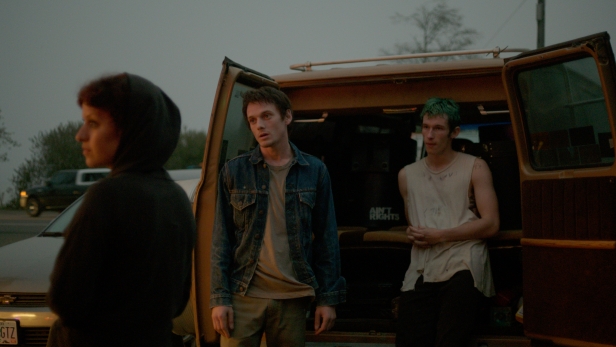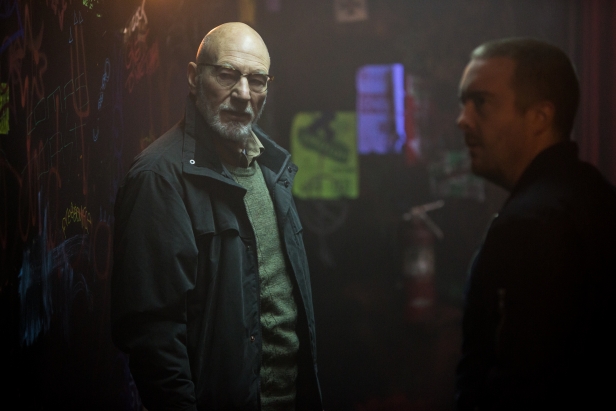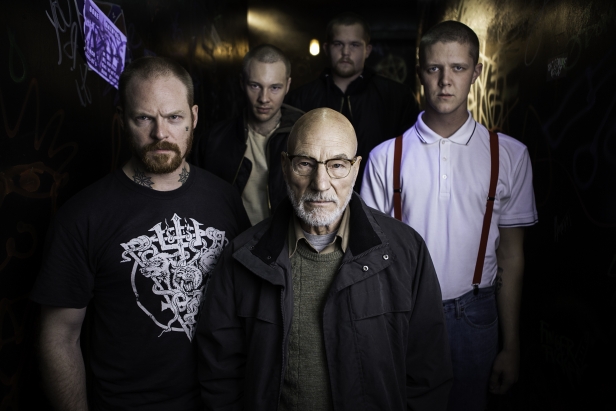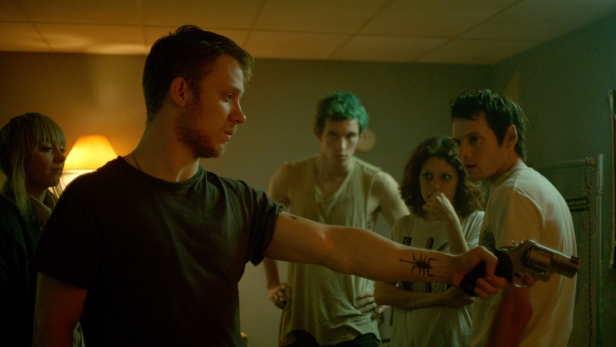Green Room is finally out in the UK and it’s definitely an experience. Blue Ruin writer-director Jeremy Saulnier has crafted a brutally violent siege horror about young punk band The Ain’t Rights (played by Anton Yelchin, Alia Shawkat, Joe Cole and Callum Turner) who witness a murder after playing a gig at a right wing bar.
Suddenly they’re trapped in the green room, while bar owner Darcy (a terrifying Patrick Stewart) prepares to do whatever it takes to get in.
It’s a brilliant film (read our review here) that introduces you to an incredible likeable group of characters before putting them through a John Carpenter-esque siege nightmare. We got the chance to talk to Saulnier about sloppy violence, punk politics, Patrick Stewart and his collaboration with Macon Blair.
Where did Green Room come from?
It had been bouncing around in my head for almost a decade. After spending time with bands and in bands, I love the environment and thought it was under-utilised. It seemed like a really cool setting for a genre flick. The punk hardcore aesthetic is just really cinematic, and I just thought “How cool would it be for a show to go horribly wrong?” I’ve always thought this premise would be great. It’s an idea that actually predated Blue Ruin so I had to get it out of my system before I moved on!
I was kind of surprised that the punk scene had a hard right-wing element but it does feel upsettingly relevant…
Punk and hardcore is very anti-establishment and that can break right and left. The movement itself, the scene if you will, is very progressive and tight-knit. But there’s this fringe element, the hate-mongers, and I think it’s easily attributed to that culture because of the aggression of the music. It does attract a certain amount of aggression and violence and physicality. I think it’s just an offshoot where that aggression is perverted and politicised in a way that’s contrary to the intent of the movement.
It was certainly more prevalent in the 90s and unfortunately it is becoming relevant again today. When I wrote the script, I sent it out to a few close friends and colleagues in the industry and a couple of people were curious if this was supposed to be a throwback to the 80s. When I wrote it, it was a timeless throwback to the 90s. But unfortunately it’s become more relevant in the last two or three years.

Were you consciously looking at things like Assault On Precinct 13 for inspiration?
Assault On Precinct 13 seemed like such a close reference that I was afraid to even watch it! Up to 2014, I actually never watched John Carpenter’s siege movie. I decided it would be a great reference but I wouldn’t watch it until after I’d finished the screenplay. So after I’d finished the second draft of the script I did sit down and watch it, and it was indeed an influence after the fact.
I loved the simplicity of it and the raucous overnight tension building experience. That it didn’t overreach or try and be too lofty. It was just this really cool, blunt force textural film, and it was great. And I liked it because it wasn’t a horror movie. It was certainly exploitation, and it was this gritty badass crime thriller movie, but it served as a guide in that I was going to do some pretty heavy violence and make-up effects and all that.
[Green Room] can be assigned horror film status by the industry and the audiences, I have no problem with that, but I treated it as a small scale war movie. A lot of my references were Apocalypse Now, Platoon, some early Michael Mann is always an influence in my films just because I love the aesthetic that he builds. Those are the primary references that I was highlighting to my cast and crew. To treat it like a war movie and not a horror film.
The violence is definitely heavy! It’s brutal, it’s kind of clumsy and it hurts, like it did in Blue Ruin. Is it important to you that the violence does have that impact?
Oh sure, I think it’s more responsible to make violence brutal and emotionally and narratively impactful, and not just a throwaway textural element of the movie. It has to drive the narrative and it has to really enhance the experience just by treating it as what it is, it’s awkward and without varnish, and the choreography associated with the violence is sloppy and haphazard and sort of immediate. I use it as a tool; I think it’s emotionally responsible and narratively appropriate. With a few exceptions!
I’m also a big genre film fan, so there are times when I will indulge in a badass action sequence for the sake of a badass action sequence. As long as I don’t veer too far off course. Blue Ruin was more of a stark emotional film that is certainly a cautionary tale. Green Room is certainly a brutal intense experience and it’s absolutely not supposed to celebrate violence, but I think it’s a little more firmly in the exploitation genre film category and unabashedly so.

Obviously it helps that the characters are so likeable. Could you tell us about creating The Ain’t Rights?
It’s just so important to me to have things grounded emotionally and I just love seeing real people on screen, it’s that simple. You so often see movies with hyperbolic characters, invincible hitmen, everyone’s got some kind of secret history or tradecraft to lean on to get ’em out of a situation! I like seeing regular humans put in these well-worn cinematic scenarios, you get to explore a whole lot of new territory. It’s this direct and immediate relationship you establish with your audience, when these don’t feel like fictitious characters. These feel like people I know.
And it’s about casting, it’s about being indifferent to fame or assessed foreign sales value, whatever the fuck the industry wants to assign people, it’s just: do you have the chops? If you’re dedicated to assembling a team that is invested in telling a story then you’re really safe. I just build up a team of likeminded, talented individuals who bring a lot to their characters and serve as their protectors, and I just kind of unleash them. It’s really fun to work with such talented people.
For me, what I’m not attracted to as a filmmaker in my own cinematic endeavours would be artificiality and false notes. Things that are done for the convenience of the narrative or the audience. I like real characters to interact amongst themselves, I never like them talking to the audience for their sake. I hate exposition, and I play with that. I kind of veer towards cinematic convention and then I disallow it, and it’s kind of fun for audiences to be taken on that ride where I’ll write myself into corners, and if there’s no easy solution, I’ll make the characters suffer for it!
It’s fun to keep it grounded from the actors’ point of view, and they appreciate it. We’re not casting a bunch of action heroes, so you have actors who are rarely allowed the opportunity to star in action movies, and that just embrace that opportunity and love to get their hands dirty. Imogen Poots rarely gets the chance to go full feral and wield a shotgun and just go bananas!

Patrick Stewart’s performance as Darcy is great too. Had you always envisioned it as this quiet character, rather than someone bellowing and ranting?
What’s really terrifying about violence is its brutal indifference. It’s not these convoluted maniacal evil plots, it’s just self-preservation and a disregard for others. For Darcy’s character it was fun to have a man of such presence in Patrick Stewart give this really grounded performance. It was all about pragmatism. Brutal pragmatism. He took no pleasure in this. He’s simply trying to preserve his self-interests and clean up this mess that he’s not responsible for, but he will pay the price for if it gets out.
So keeping him on that level of efficiency and pragmatism and not diabolical sadism was the key there. We worked intimately to achieve that, and he remarked on set that it was the quietest he’s ever spoken on stage or on screen in his life. And I think that was a really fun thing to do, to take a man of such presence and bring him down several notches, and let his actions speak louder than his words.
I did want to ask about your collaboration with Macon Blair, who co-wrote and starred in Blue Ruin and plays Patrick Stewart’s henchman here, and you guys are writing your next film together.
I consider him a creative partner. He gets the first peek at anything I write and I get a peek at whatever he writes, we’re so creatively in line that he can really step in for me when I’m either incapacitated or otherwise consumed by other duties. He’s along for the ride as a co-producer, from the beginning of Green Room. He’s also just a fabulous talent on screen. We grew up together from grade school onward. We’re just used to wearing multiple hats so we trade off and try and support each other the best we can.
But I’m also very disciplined about…I never give him anything. In fact after Blue Ruin I couldn’t shake his performance right away so he ended up having to audition for Green Room. He surprised me with a self-taped audition for the role of Gabe. But it was so clear, once I saw him on tape, that this was not an act of nepotism, this was just an opportunistic thing for me to snatch him up for another great role, and he adds so much to the story.
And it was fun because it ended up being that Macon Blair, my grade school buddy, shared most of his scenes with Patrick Stewart! The shoot itself was such a whirlwind and a really crushing experience for me because, man, it was really tough to pull off, but one time I was sitting behind the camera watching a take of Macon Blair, a high school buddy, and Sir Patrick Stewart, world-renowned movie and stage star, walk through a death metal concert together. I was just like “This is the coolest thing I could ever imagine!” Me as a child would be flabbergasted that I actually pulled this shit off! So it was one of the highlights of my career thus far.

Finally, how have you found the experience of watching Green Room with an audience?
You know, I get so close to my movies that I can no longer see them for what they are. My key crew, my editor Julia Bloch, we really went all the way in for this edit, we were tweaking frames till the very last minute. So I only watched the movie once with an audience and it was at the Cannes premiere, and it needed some sound mix finishing. And I watched it again to take sound notes, and I finished it, and it’s such a different film. We actually premièred a new sound mix at Toronto; that is the movie. Once I knew technically that it was as good as I could make it, I have not watched it, but it’s better and healthier for me to attend screenings and just feel the audiences’ charge after.
I really enjoy experiencing it through the audience but passively. I will revisit the movie but what I feed off is the audience’s energy. As far as I’m concerned, it’s always audience first. When I write films it’s as an audience member watching the film unfold on the screen, so they’re always my direct target. There are always industry considerations, but I aim to please my fans, and not in a condescending way. I like to challenge them and excite them and surprise them, and so far, so good.
Green Room is out in cinemas now. Read our review here and keep up with the latest genre news with the new issue of SciFiNow.
